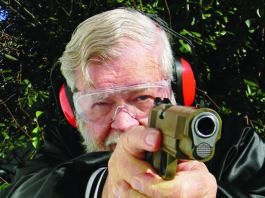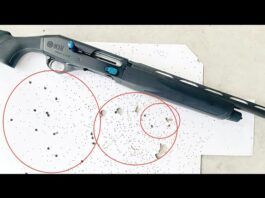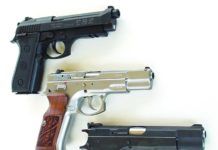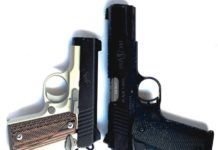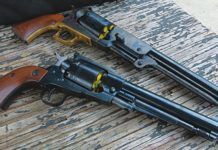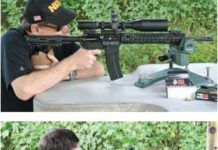6mm Creedmoor Bolt-Actions: Barrett, Browning, and Howa
Barrett's Fieldcraft is great for backpacking, and the Browning Hell's Canyon can compete on Saturday and hunt on Sunday. Howa's H-S Precision is a fine all-purpose rifle in this trending long-range round.
10 Things Gun Owners Get Wrong About Their Self-Defense Rights
For six years, I was an attorney for a national firearms legal-defense program. I represented gun owners who acted in self-defense and traveled the country speaking on firearms issues. I've taken countless questions regarding a person's legal right to self-defense. Over the years, I started to see a pattern — people have the same questions. From your brand-new gun owner to the seasoned carrier, the questions and misconceptions were the same. I've heard it all, and nothing catches me off-guard, so I've drawn on these experiences to put together the top 10 misconceptions gun owners have when it comes to their self-defense rights.
Selective-Double-Action 9mm 3-Way Used-Handgun Shoot Out
The selective-double-action handgun isn't always well understood by the buying public. Yet, for many, this action represents the best combination of speed, readiness, and safety. The CZ 75 is easily the best known of the type, but other makers have offered selective-double-action-operation handguns. Recognizing the current popularity of the high-capacity 9mm handgun, our team went searching for good buys in this popular chambering. We wished to test the accuracy of a number of selective-double-action (SDA) handguns. With a long trigger press for combat use with the first shot and excellent accuracy potential in the single-action mode, we feel that these service-size handguns offer a good choice for many shooters. We tested the following handguns:
Action Arms ITM AT-84. This pistol is among the units assembled and finished in Switzerland from Tanfoglio parts. It is perhaps twenty years old. This pistol is similar to the modern CZ 75; however, it is a pre-B, in that there is no firing-pin block or drop safety. Modern magazines fit the AT-84, but AT-84 and pre-B CZ 75 magazines will not lock into the modern CZ75B. The original spur hammer is used on the AT-84. All in all, it offered a pleasant and perhaps retro appearance. This pistol isn't offered in a current configuration, so you would have to roam the used-gun counters and the bowels of the internet to locate one. But they are out there in reasonable numbers.
CZ 75 B Matte Stainless 91128. We have previously tested a 75B, in the June 2016 issue, Model No. 01120 in 40 S&W. The ‘B' designation indicates that the model is equipped with a firing-pin-block safety. That CZ 75B was finished in a black coating, and the pistol's dust cover is thicker than on the 9mm, so some holsters, such as the tightly fitted Lobo Gunleather IWB, would require a significant break-in period before the handgun will properly fit a holster blocked for the 9mm CZ 75 B. The sights on that pistol were enameled with a green three-dot treatment. The paint was self luminous and glowed green for some time after being exposed to light. Raters were split on the CZ 75 B. All gave the pistol high marks for reliability. Accuracy was excellent, and the pistol was comfortable to fire. The lack of a decocking lever was a serious drawback to some, and it didn't have an accessory rail. In the August 2008 issue, we tested a 75 B in 9mm, it also with a blued finish. We said of that B+ handgun: "The single-action CZ 75 B was one of the finer 9mms we've tried. It fit our hands well, pointed superbly, was reliable, comfortable and pleasant to shoot. The only flaw we found in this sample was a trigger that needed work. This gun had an ambidextrous safety that did not interfere with the shooting hand. The only control other than a two-position hammer (no half-cock position, and none needed) and the trigger was the slide lock, which was also the takedown lever." A few months later, we looked at another 75 (B-), this one a 16-shot double-action pistol that "can be carried cocked and locked, which solves problems for some who are required to pack a DA pistol. The matte-black finish was well done, and the entire gun seemed to be built to last." The accuracy of the CZ was about 2.5 inches for all shots fired, and we thought that was more than adequate. The CZ was notably heavier than the M&P, and that helped dampen recoil. There were no problems with the CZ whatsoever. It fed, fired, and ejected all our loads. We liked the fact that it could be fired with the magazine removed. The empties didn't go far, but they all got out of the gun. Other than the poor trigger and its sharp edge, we liked this gun. It appeared to be very well made." If buying used firearms isn't your thing, this pistol is still being offered under the 91128 model number.
Taurus PT 92 AF 92B-17. We tested an early incarnation of this pistol in the June 1994 issue. We looked at a Taurus 92 AF 9mm, saying of it, "Overall, this Taurus' trigger was satisfactory. The trigger itself was 3⁄8-inch wide and had a smooth face. In the single-action mode, the pull had almost a half-inch of take-up before breaking at 6 pounds. The long double-action pull had a full inch of travel. However, it released with only 10.5 pounds of pressure, making it easier to control than most. Bottom Line: The PT 92 performed satisfactorily so long as it was heavily lubricated, but eliminating the [tool] chatter marks on the slide rails seems a better option to us."
Hot New Pistols from Kimber And Browning Shoot It Out
John Browning's 1911 handgun design has been produced the world over in some of the finest factories in the world, as well as some copies beat out on a rock in Afghanistan. Some 1911s have been downsized — in what they shoot — to a variety of cartridges smaller than 45 ACP, such as 40 S&W, 38 Super, 9mm Luger, and 22 LR, to name just a few. The handguns reviewed here, the Browning 1911-380 and the Kimber Micro Carry Advocate, are likewise downsized in cartridge to the 380 ACP (aka the 9mm Kurz, or 9mm Short), and they are physically downsized as well. This has been done before in the form of several variations by Colt, the Mustang being among the best known. Older raters fondly remember the Star 380 ACP handguns that were available in both service-size and micro-size variants. Going further back, the Colt 1903 Pocket Hammerless that preceded the 1911 was a compact 32 ACP pistol that saw action all over the world. It was also chambered for the 380 ACP in later variations. The popularity of the 380 ACP round is certainly a result of its easy shooting characteristics, made even easier in the larger variants with bigger grips and more weight.
The 1911 market is huge, as is the 380 ACP market, but there are only a relative handful of firearms that combine the ergonomics of the former and the soft recoil of the latter. In particular, Browning and Kimber are not willing to leave the 380 ACP market to Colt and SIG, so they have attempted to marry the big gun's controls with the pocket pistol's shootability in their respective handguns, the 1911-380 and the Micro Carry Advocate. Each rides on the coattails of the full-size 1911; however, only the Browning is a true miniaturized 1911. We call the Kimber "1911-like."
In this test, our shooters found out that both sidearms work well, and that the Kimber is a very good pocket pistol to boot. The Browning will not fit in an average pocket, and that makes its place in the scheme of personal-defense carry guns problematic. Here are more of our insights on these two handguns:
(Gunsmithing Made Easy #1) A Lousy Conversation
To be blunt, if you fire even a single round at the shooting range or in your shop with the Snail Trap without high-quality eye and ear protection, you are a total moron. One simple question, how much hunting, shooting or tinkering on guns are you going to be doing when you are blind? I suppose you can still do most of that if you are deaf, but it won't be fun and your success will be less than sterling.
Pillar Bedding Your Rifle
Any mass-produced product, no matter how technically advanced, will have manufacturing tolerances that will dictate a variation in the dimensions of the parts. Rifles are not exempt from this, but it is inarguable that with the increasing use of computer controlled manufacturing machines, today's factory rifles have reduced these tolerances dramatically. Enough, it would seem, that the accuracy goals of a "tuned" rifle from a couple of generations ago are generally close to the minimum out-of-the-box standard today. However, while we may be getting closer, perfection is still elusive.
Convertible Cap & Ball Models: Ruger Old Army and Colt Walker
The collaboration between Samuel Colt and Captain Samuel Hamilton Walker in 1846 resulted in the Colt Walker revolver, a massive six-shot 44-caliber handgun. The largest and most powerful percussion revolver ever made, it weighed nearly 5 pounds and was more than 15 inches long. Captain Walker wanted a revolver for cavalry troops that could dispatch opposing adversaries as well as horses in close combat situations. The massive Walkers were held in pommel holsters thrown over a saddle horn. Captain Walker used a pair of his namesake revolvers during the Mexican-American War and was killed in action shortly after the Colt Walkers began production. Numerous copies of the Walker are available today, with most made in Italy by companies like Uberti and Pietta. However, our second-generation Walker tested here was made by Colt Blackpowder, which was, at one time, part of Colt in the 1970s thru the 1980s. The Italian companies manufactured components, and Colt Blackpowder finished the gun. Our test item is known by collectors as one of the "black box" percussion Colts because it was packaged in a black box. Many shooters will recognize the Walker as the handgun Clint Eastwood carried in a belt rig in the movie The Outlaw Josey Wales.
Bill Ruger loved old guns, and his design for what he called the finest percussion revolver was the Old Army, introducing the cap-and-ball revolver in 1972. Ruger built the design around the old three-screw Blackhawk revolver. Unlike the popular open-top Colt percussion revolvers like the Walker, Ruger's Old Army uses a full frame with top strap and looks very similar to the Remington Model 1858 percussion revolver. Ruger redesigned the loading lever to be more secure and added adjustable sights. Adjustable sights on a black-powder revolver was virtually unheard of, and they take the guesswork out of shooting these revolvers, as you will see.
While we wanted the authentic black-powder experience, we also wanted to see how a cartridge-conversion cylinder would fare in these handguns. Taylor's & Co. (TaylorsFirearms.com) imports cartridge-conversion cylinders from Italy, so we ordered a 45 Long Colt cylinder for both the Walker ($250) and the Old Army ($240) from Brownells.com. The back plate, or rear of the cartridge conversion cylinder, is pulled off, the cylinder loaded with cartridges, the back plate replaced, and then the cylinder is inserted into the revolver's frame and the revolver reassembled. It takes longer to describe than to do in actual practice for one of these revolvers. The back plate holds six firing pins, and a pin in the cylinder and a hole in the back pate mate to ensure they are reattached the same way each time. The cartridge-conversion cylinders are not conducive for fast reloads, but they do allow shooters to fire cartridges in percussion-style guns without the fuss of loose fixin's like ball, caps, and powder. In fact the Taylor's & Co. cylinders are patterned after an original Remington design for a drop-in fit.
(AR-15 Rifles ebook Part 2 #1) Compact AR-15s
The popular AR-15 platform is spurring modifications on over-the-counter guns that heretofore were the province of do-it-yourselfers who had a Brownells catalog and a credit card handy. Two modifications of the original design found on more and more ARs are the "tactical" forend, consisting of a four-sided Picatinny rail and flip-up sights that can be raised into position when needed. The tactical forend is especially useful when applied to a flat-topped receiver topped with a matching Picatinny rail. The forend rail can receive any type of laser or illuminating device that carries a clamp. These features were developed to answer the needs of military and law enforcement and action-rifle competitors.
The AR-15 platform lends itself to fulfilling the needs of the user like no other design, which made our task of assembling four different carbines both a challenge and a pleasure. They are the $1054 DPMS RFA2-AP4A Patrol Carbine and a Bushmaster Patrolman's Carbine No. BCWA3F 16M4, which comes with options that bring the total suggested retail price to $1534. Each of these compact ARs offer the tactical forend and flip-up sights mentioned above and a flash hider, adjustable-length stock, and single-stage trigger. Also, the DPMS Patrol Carbine and the Bushmaster came with A2-style front sights that were adjustable for elevation.
Both were chambered for .223 Remington or 5.56mm rounds. For test ammunitions, we chose two premium rounds and the highest quality, most economical remanufactured ammunition we could find. The premium rounds were 62-grain Hornady TAP and 62-grain Federal American Eagle FMJ ammunition. To perform the bulk of the work, such as zeroing our scopes and performing rapid-fire drills that ate up hundreds of rounds, we chose 55-grain full-metal-jacket rounds from Georgia Arms (Georgia-Arms.com).
Our test procedure was arduous. To collect accuracy data we fired five-shot groups from the 50-yard benches at American Shooting Centers in Houston (AMShootcenters.com). Each gun was tested with the supplied open sights and with a Millet DMS-1 variable power scope set at 4X magnification. Mounting the scope with Zeiss rings upon a one-piece riser from Yankee Hill Machine (part number YHM-227A, $33 from YankeeHillMachine.com) made the transfer from gun to gun simple.
For the results of this test of four compact ARs, purchase the AR-15 Rifles E-Book, Part 1 from Gun Tests.
Steyer AUG Firing Demo
The short-frame and compact British Bullpup is a well-known military weapon. In the AUG, Steyer has introduced its own interpretation of this classic. Gun Tests Roger Eckstine recently tried one out the Last Vegas SHOT show.
A Bigger Stick: We Test AR-15s In 6.8 SPC from BRC and LWRCI
Throughout American history, citizens have adopted the military arms of the nation for civilian use. Today, the military-based semi-auto AR-15 platform is showing the genius of Eugene Stoner by being adopted for a multitude of uses, in particular as a hunting round for medium-sized big game. One cartridge particularly suited to this role is Remington's 6.8 SPC, an intermediate cartridge originally developed by the U.S. Army's Marksmanship Unit and Special Forces personnel to provide more power and penetration than the standard 5.56 NATO round, while maintaining compatibility with the AR-15 platform. The 6.8 SPC round, topped with appropriate hunting bullets, is currently being used in the field to harvest deer, hogs, and other large game. Thus, our interest in testing two very different rifles chambered in this cartridge, the LWRCI M6A2 and the Battle Rifle Company M4 Odin.
The 6.8 SPC is a cartridge that pushes the performance envelope for the AR-15 platform. Over time, there have been several specifications published for the chamber, with a great deal of discussion regarding the compatibility between the different specifications. However, the available data shows the differences between chamber specs are minimal, so compatibility should not be a problem. It's worth noting, though, that one ammunition brand in this test, Silver State Armory, suffered two case ruptures. As there was one rupture in each rifle, and both failures were early in the testing cycle, we are inclined to think the issue was with the ammunition and not the rifles' designs or cleanliness. Having two ruptures in one test does not inspire confidence in the ammunition, so we wanted to mention that immediately.
LWRCI is headquartered in Cambridge, Maryland. The company says its mission is to provide "durable tools for the warfighter and law enforcement officer." According to the company's website, LWRC International (LWRCI) "was founded to pursue the development of a short-stroke gas-piston-operated version of the AR-15/M16/M4 family of weapons." The company says it focused on eliminating the inherent shortcomings in the direct-impingement operating system, resulting in the family of M6 rifles and carbines.
The LWRC International M6 series rifles are rotary-bolt, magazine-fed, air-cooled, self-loading designs chambered in 5.56x45mm NATO and 6.8x43mm SPC. Some of the more common variations include the M6SL, a lightweight mid-length unit with polymer handguards; the M6A1, which has an A-frame front sight and quad-rail handguards; the M6A3, which has a four-position gas block, a mid-length action, and a mid-length quad rail; and the M6-SPR, which has a low-profile gas block and SPR configurable rail system. Our test unit was the M6A2 version, which has a low-profile gas block with a mid-length quad rail and heavy-duty polymer rail covers. The M6A2 retains about an 80% parts commonality with the direct-impingement carbine.
Battle Rifle Company was started in April 2010 and is based in Houston. The receiver on our rifle was stamped Seabrook, Texas. The company sells direct to the consumer or through its dealer network. The BR4 Odin gets part of its name from the Odin Works 12.5-inch keymod rail, which keeps weight down while allowing many accessory configurations. The BR4 designation is what the manufacturer gives all its guns with a 16-inch or shorter barrels. The 14.5-inch barrel has a Battle Rifle flash suppressor mounted permanently. The gun comes with a soft zippered case and one 25-round magazine. This was a direct-gas-impingement action, so it allowed us to compare it head to head with the piston gun for cleanliness, coolness, and function.
Just Right Carbine Follow-Up
The first time we tested the Just Right Carbine in the June 2014 issue, we had beaucoup malfunctions and gave the rifle a D grade. Yet, the rifle seemed to have promise. Handling was good to excellent, the light-rail well designed, and compatibility with Glock magazines gave good utility. The accuracy test was a struggle due to malfunctions. But we did not have to go through hell and high water to get it working. We sent it back to the factory. When it returned, the JRC carbine was a different bird and sang a pretty tune. And we just may have learned a few things about pistol-caliber carbines in the second test. Make no mistake, it is best when the firearm works the first time, but the Just Right Carbine has potential. Heres what we thought after the follow-up test.
A Trio of Mako AR Accessories
The list of extras and "hop-up" parts for the AR-15 never seems to stop growing. Some of these parts are just for looks, but others do have a lot to offer. In the case of adjustable-length buttstocks, many are designed to improve cheek weld and offer a more secure, wobble-free locking system. We bought a pair of $122 FAB Defense Survival Buttstock GL-MAG units from TheMakoGroup.com to see what utility they might give us over a standard stock. We installed them on two different AR-15 carbines.
Promotional materials for the stocks said they provided a spare magazine well located immediately forward of the buttpad. The obvious advantage is that you can pick up the rifle and have an extra magazine in tow. In addition to extra rounds, a loaded magazine located in the buttstock provides ballast, allowing the operator to re-balance the rifle as he prefers.
The Survival Buttstock will stow any length or capacity AR-15 magazine (but not magazines for AR-10s).
The Survival Buttstocks arrived with 10-round magazines in place. The magazine-release buttons were located on the left side of the buttstocks.
We installed one stock on a carbine built to Mil-Spec standards and the other on a commercial-size tube. Installation was by standard procedure, simply slipping them on the buffer tube. The initial inlet of the Survival Buttstocks had some extra material that was not apparent when installing on the commercial-size AR-15. It glided smoothly into place, yet didn't wobble at all on the buffer tube. Getting the buttstock onto the buffer tube of our Mil-Spec AR-15 was more difficult. But a call to Mako's service rep assured us to go ahead and be more forceful. Once past the extra detent, the buttstock was secure and still moved easily forward and back.





























